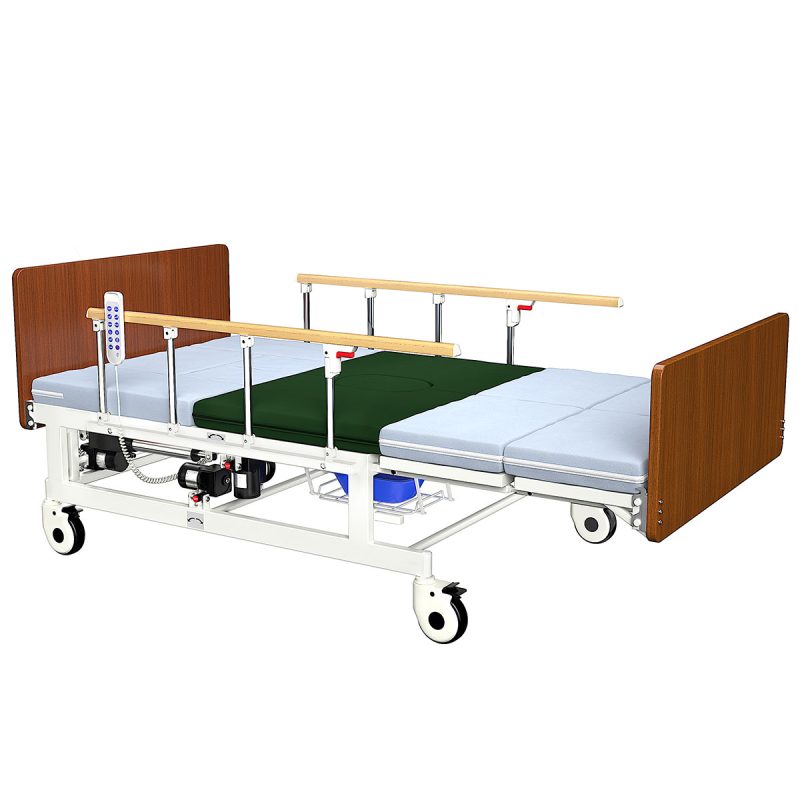To assemble a hospital bed, follow these expert steps:
- Gather Tools and Instructions: You’ll need a screwdriver, wrench, pliers, and Allen wrench. Refer to the manufacturer’s instructions for specific guidance.
- Prepare the Area: Ensure you have ample space and a clean, flat surface.
- Assemble the Bed Frame: Connect the head and foot sections of the frame using bolts and screws. Tighten securely with a wrench or screwdriver.
- Install the Mattress Platform: Attach the platform to the frame. If the bed is adjustable, connect the motors to the appropriate sections.
- Attach Side Rails: Secure the side rails to the frame, ensuring they can be raised and lowered smoothly.
- Install Casters: Attach the wheels to the bed frame and check that they lock and unlock properly.
- Connect Electrical Components: For electric beds, connect the motor and control box according to the instructions. Test all functions to ensure proper operation.
- Place the Mattress: Position the mattress on the platform, ensuring it is secure.
Finally, conduct a thorough safety check, ensuring all connections are tight, movements are smooth, side rails lock securely, electrical components function correctly, and casters lock firmly. This ensures the bed is safe and functional for patient use.
If you are considering purchasing a hospital bed, please visit the official website of epachois,here:https://www.epachois.com/where the fully electric hospital beds are of high quality and extremely low prices.

What Tools Are Needed to Assemble a Hospital Bed?
Before starting, gather the necessary tools. Most hospital bed assembly requires basic tools such as:
- Screwdriver: Both flathead and Phillips types may be needed.
- Wrench or Socket Set: Useful for tightening bolts and screws.
- Pliers: Handy for gripping and twisting components.
- Allen Wrench: Often included with the bed for specific bolts.
Ensure you have the manufacturer’s instructions, which usually detail the specific tools required.
What Are the Main Components of a Hospital Bed?
Understanding the main components is crucial for proper assembly. A typical hospital bed consists of:
- Bed Frame: The foundation, including head and foot sections.
- Mattress Platform: The surface on which the mattress sits, often adjustable.
- Side Rails: Safety features that can be raised or lowered.
- Motors and Controls: For adjustable beds, these components allow for head, foot, and height adjustments.
- Casters or Wheels: Enable mobility of the bed.
- Accessories: Optional parts like IV poles or over-bed tables.
Familiarize yourself with these parts to streamline the assembly process.
How Do You Assemble a Hospital Bed Step by Step?
Follow these general steps to assemble a hospital bed:
- Prepare the Area: Ensure you have enough space and a clean, flat surface to work on.
- Assemble the Bed Frame: Connect the head and foot sections according to the manufacturer’s instructions. Secure with bolts and screws, using a wrench or screwdriver.
- Install the Mattress Platform: Attach the platform to the frame. If the bed is adjustable, connect the motor(s) to the appropriate sections.
- Attach the Side Rails: Secure the side rails to the bed frame. Ensure they move up and down smoothly and lock into place.
- Install the Casters: Attach the wheels to the bed frame if they are not pre-installed. Ensure they lock and unlock properly.
- Connect Electrical Components: If the bed is electric, connect the motor and control box according to the instructions. Test the bed’s functions to ensure everything works correctly.
- Place the Mattress: Position the mattress on the platform, securing it if necessary.
How Do You Ensure the Bed Is Safe and Functional?
After assembly, it’s essential to check the bed for safety and functionality:
- Inspect All Connections: Ensure all bolts, screws, and connections are tight and secure.
- Test Movements: Raise and lower the head, foot, and overall height of the bed to ensure smooth operation.
- Check Side Rails: Confirm that the side rails lock securely in both raised and lowered positions.
- Verify Electrical Components: If applicable, test the remote control and motorized adjustments to ensure they function correctly.
- Lock Casters: Ensure the wheels lock firmly to prevent unwanted movement.
Regular maintenance checks should be performed to ensure ongoing safety and functionality.
By following these steps and taking the necessary precautions, you can successfully assemble a hospital bed, ensuring it is safe and functional for patient use. Always refer to the manufacturer’s instructions for specific details and guidance.

